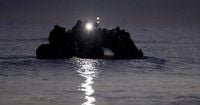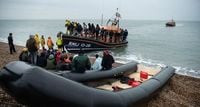In the early hours between September 26 and 27, 2025, the English Channel once again became the site of tragedy as two women lost their lives attempting the perilous crossing from northern France to Britain. The incident, which unfolded just south of the beaches of Neufchâtel-Hardelot—between the coastal towns of Boulogne and Le Touquet—has reignited urgent debate over the ongoing migrant crisis and the effectiveness of recent Franco-British efforts to stem the tide of dangerous crossings.
According to French authorities, around 100 people set out that night in a makeshift boat, braving the Channel’s notorious currents and frigid waters. As reported by AFP and confirmed by local official Isabelle Fradin-Thirode, approximately 60 survivors were rescued from the water and are now receiving care from emergency services. Among those saved was a couple and their child, who suffered from moderate hypothermia and were rushed to a hospital in Boulogne for treatment. The remaining survivors are being looked after by authorities, though the trauma of the night’s events will likely linger far longer than the physical wounds.
While the identities of the two deceased women have not been officially confirmed, French newspaper La Voix Du Nord reported that they may have been Somali nationals. Their deaths bring the Channel crossing fatality count to at least 25 so far in 2025, based on tallies from AFP and official data. The International Organisation for Migration (IOM) has also documented several more deaths believed to be linked to Channel crossing attempts in both 2024 and this year.
Tragically, this latest incident is part of a grim pattern. Last year alone, 50 people died attempting the same journey, marking 2024 as the deadliest year on record since the Channel crisis began. Despite repeated warnings about the dangers of the crossing—ranging from busy shipping lanes to unpredictable weather and cold temperatures—the number of attempts has surged. Since January 2025, more than 31,000 migrants have reached Britain by crossing the Channel in small boats, a record high for this point in the year since official data collection began in 2018, according to AFP and The i.
The reasons driving these desperate journeys are complex and deeply personal. Many migrants, like Saad—a 30-year-old Palestinian from Iraq interviewed by AFP in a makeshift camp near Dunkirk—describe a sense of hopelessness if forced to remain in France or return home. For some, the perils of the Channel seem less daunting than the threats or deprivation awaiting them elsewhere. “Staying in France or returning home both represented certain death for me,” Saad told AFP. Stories like his are echoed by hundreds of others, observed by reporters as they prepared to cross from northern France whenever the weather allowed.
Against this backdrop, the governments of France and the United Kingdom have sought to curb the crossings through a new “one-in, one-out” deportation scheme. Under the agreement, the UK is permitted to return ineligible asylum seekers to France—particularly those who have passed through what are deemed “safe countries” en route to Britain. In exchange, London agrees to accept an equal number of migrants from France who are likely to have their asylum claims approved via legal routes. The arrangement, which was intended to create a more orderly and humane system, has so far delivered underwhelming results.
As of late September, only six deportations have been executed under the new scheme, while more than 1,100 arrivals were recorded in the past week alone, according to The Guardian and Daily Mail. The four individuals already deported—Indian, Eritrean, Iranian, and Afghan nationals—highlight the diversity of backgrounds among Channel migrants, but their small number underscores the challenge of enforcing the agreement at scale.
British ministers maintain that the pace of removals will increase in the coming months, insisting that the scheme needs time to take effect. However, critics are not convinced. Opponents accuse Prime Minister Sir Keir Starmer’s government of losing control over Britain’s borders, arguing that the policy has failed to deter crossings or provide a meaningful solution to the humanitarian crisis. Meanwhile, supporters of the agreement point to the need for international cooperation and a rules-based approach to asylum, urging patience as both countries work out the operational kinks.
On the ground, humanitarian organizations continue to grapple with the fallout. In Calais and other parts of northern France, the Red Cross and similar groups operate medical clinics to treat conditions ranging from diphtheria to tuberculosis—diseases that thrive in the unsanitary and crowded conditions of migrant camps. Emergency services remain on high alert, regularly responding to distress calls from boats in trouble or to cases of hypothermia and exhaustion among recent arrivals.
The Channel’s dangers are not lost on those who attempt the crossing. The waterway is one of the world’s busiest shipping lanes, subject to strong currents, sudden weather changes, and low temperatures even in late summer. Boats used by migrants are often overcrowded and poorly constructed, making them especially vulnerable to capsizing or sinking. Yet, for many, the hope of a better life in Britain outweighs the risks. As one official noted, the determination of migrants to reach the UK has “mostly endured acute hardship and dangers to come so near their ultimate goal.”
Observers say that while increased enforcement and new agreements may slow the flow temporarily, they are unlikely to address the root causes of migration—conflict, poverty, and instability in home countries, as well as the perceived opportunities in Britain. As long as these factors persist, the Channel will remain a magnet for those seeking safety or a fresh start, regardless of the dangers.
For now, the deaths of two women off the coast of Neufchâtel-Hardelot serve as a somber reminder of the human cost of Europe’s ongoing migrant crisis. As governments debate policy and enforcement, the Channel’s cold waters continue to claim lives, leaving survivors and families on both sides of the sea to mourn and wonder if a better solution will ever emerge.





